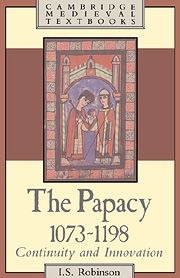Book contents
- Frontmatter
- Contents
- Preface
- List of abbreviations
- BIBLIOGRAPHICAL NOTE
- PART I THE PAPAL GOVERNMENT
- 1 Rome and the Patrimony of St Peter
- 2 The college of cardinals
- 3 Papal councils
- 4 Papal legates
- 5 Papal justice and papal legislation
- 6 The papacy, the religious orders and the episcopate
- 7 Papal finance
- PART II THE PAPACY AND THE SECULAR POWERS
- Appendix A list of popes, 1073–1198
- Index
1 - Rome and the Patrimony of St Peter
Published online by Cambridge University Press: 05 June 2012
- Frontmatter
- Contents
- Preface
- List of abbreviations
- BIBLIOGRAPHICAL NOTE
- PART I THE PAPAL GOVERNMENT
- 1 Rome and the Patrimony of St Peter
- 2 The college of cardinals
- 3 Papal councils
- 4 Papal legates
- 5 Papal justice and papal legislation
- 6 The papacy, the religious orders and the episcopate
- 7 Papal finance
- PART II THE PAPACY AND THE SECULAR POWERS
- Appendix A list of popes, 1073–1198
- Index
Summary
The bishop of Rome ruled over a diocese which in the period 1073–1198 must have been the most turbulent and ungovernable in western Christendom. The city was ‘almost a ruin, broken down, reduced to ashes’: Rome's decline from her ancient splendour was a favourite theme of visiting poets. In the twelfth century a population of no more than 20,000 persons inhabited a city which at the height of her ancient prosperity had housed at least half a million. No longer a thriving economic centre, the city derived her wealth from her churches. ‘In place of the ruins of walls and ancient temples, there spring up every day innumerable buildings of churches or monasteries’: over 300 had sprung up by the end of the twelfth century. The pilgrims attracted by these churches and their relic collections provided an important part of the income of the Romans in the eleventh century. During the following century an additional source of income was provided by the litigants and petitioners drawn to Rome by the rapid expansion of papal government. It was Rome's parasitical attitude towards these strangers which prompted the well-known complaints of non-Roman historians and satirists about the avarice of the Romans. The English historian William of Malmesbury described Rome as ‘a heavenly storehouse’ inhabited by ‘a people drunk with insane fury’. They preyed on the pilgrims and ‘would shed the blood of citizens even over the bodies of the saints, whenever they could not satisfy their lust for money’.
- Type
- Chapter
- Information
- The Papacy, 1073–1198Continuity and Innovation, pp. 3 - 32Publisher: Cambridge University PressPrint publication year: 1990



